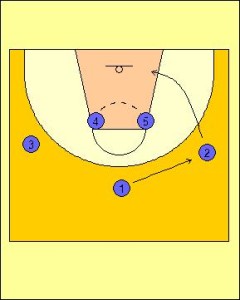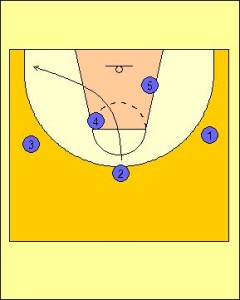Introduction to the Zipper Offense
The Zipper Offense could be run by itself or as the entrance into multiple different offenses. This was especially challenging for defences of the time and as a result the offense leads to a number of high percentage shots. The basic set-up for the Zipper Offense is a continuity offense meaning it has the ability to be run on both sides of the floor continuously. This makes it efficient and more easily taught for teams.
The Zipper Offense was a favourite of the Boston Celtics teams of the 1960s who were the winners of multiple championships. The Boston Celtics teams of the time, where headed by Bill Russell and coached by Red Auerbach These Celtics teams had both a master offensive tactician and a defensive stalwart. Coach Auerbach was able to develop and utilise the zipper offense before his competitors, and for that reason his teams were more successful in the era. The zipper offense created the term “zipper cut”, which we often use when talking about a particular cut that starts off the offense.
Today the zipper offense is still used in limited forms at the collegiate and high school level. The zipper offense is popular because it can be used an offense of its own, or it can be blended to start multiple different offenses. The offense can be started from a number of different of sets, from a 2-1-2, 1-2-2, or a 1-4. So unlike many other contemporary offenses, it can be started from different spots on the court which allow the Zipper Offense to seamlessly fit with most primary and secondary transition systems.
The Zipper Offense can also be used as a part of a secondary transition itself for quick hitter options before moving into the main half-court offense of the team. Some of the offenses regularly used in conjunction with the Zipper Offense include the flex offense, the shuffle offense, and the pick and roll offense, and a number of other motion offenses. These options give coaches a number of different possibilities to choose from, which make their attacks less predictable and more effective.
The flexibility to the Zipper Offense is one of its strongest points as it has the ability to be combined within an offensive system with a wide range. This can lead to confusion from the defences or has the versatility to be changed to create further options when a defence finally is able to close down some of the scoring opportunities.
As with most continuity offenses, the Zipper Offense itself has a number of weaknesses that can be exploited by an opposing coach who does their homework. The zipper offense relies on specific play calls, and having particular players hit specific spots on the floor at certain times. This has a tendency to be easily be scouted, and opposing teams can be prepared to take away the most high percentage shots available in the offense.
The Zipper Offense in its basic set also tends to force players into quick shots, when run all the way through, because the offense’s motion doesn’t last particularly long. These quick shots, over the course of a game, can result in lower field goal percentages (if shots are contested or the wrong player is taking the shot) and give the opposing team a better chance to win.
If you are playing against the zipper offense, you want to force the opposing team into those low percentage quick shots that the zipper offense can create. If the zipper is run well, these shots will be uncontested. But if you have scouted the opposing team and know how they like to run the zipper offense, you can take away the first few options and leave the last few players to touch the ball stranded and forced into a difficult shots or a poor passing choices. Look to try and have the weakest players having to make the shots rather than the key players within the offense getting to their favoured shooting positions.
Since the basic set of the offense itself is repetitive, it’s not entirely difficult to scout the opposing team. At lower levels of competition the offenses continuity can be as a much of a problem as a benefit. If the zipper cut or the first pass is disrupted, the entire offense is difficult to get back into rhythm for junior players. As a coach playing against the Zipper Offense try to either isolate the weakest players or specific sections of the offense which will force you opposition to ultimately change the way in which they use the offense or risk relying on their teams weakest link.

In the basic set the Zipper Offense set is a 1-4 high. Remember though the offense can be set-up from a primary or secondary transition.
The Point Guard (One) dribbles at the Shooting Guard (Two0, who performs a back cut toward the basket.
If the back cut is open, it results in a layup.
To help set this up Two should create a lead for the pass and then back-cut to the basket helping create a passing lane for the Point Guard (One).

The Centre (Five) sets a down screen, and the Shooting Guard (Two) comes off of it to the top of the key.
This is where the play presents most of its options:
- The Point Guard (One) can pass to the Shooting Guard (Two) for a shot
- The Point Guard (One) can pass to the Centre (Five) on the block
- The Point Guard (One) can wave the Shooting Guard (Two) away and run a pick and roll with the Centre (Five)
The Shooting Guard (Two) can cut to the corner instead if the defence has read the play.

If the Shooting Guard (Two) does not have a shot, the player rotates to the opposite corner.
The Small Forward (Three) move into place at the top of the key and the ball is rotated back to the point position.
The play then resets.







